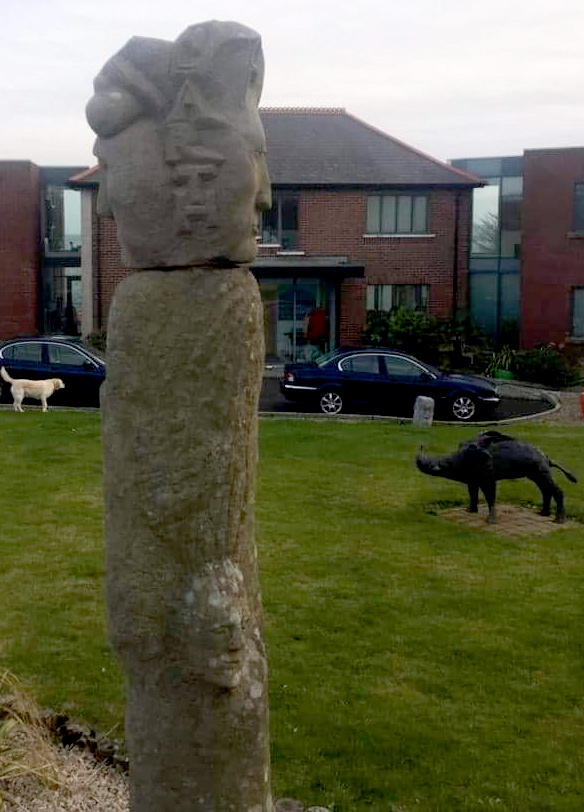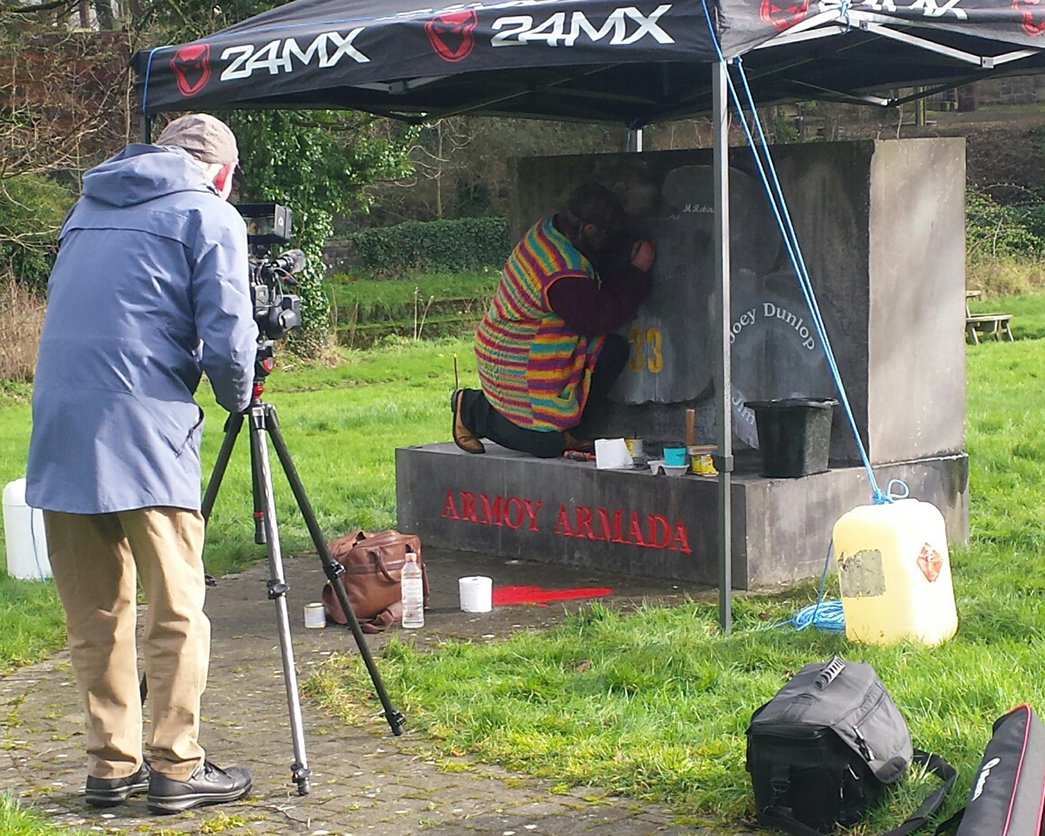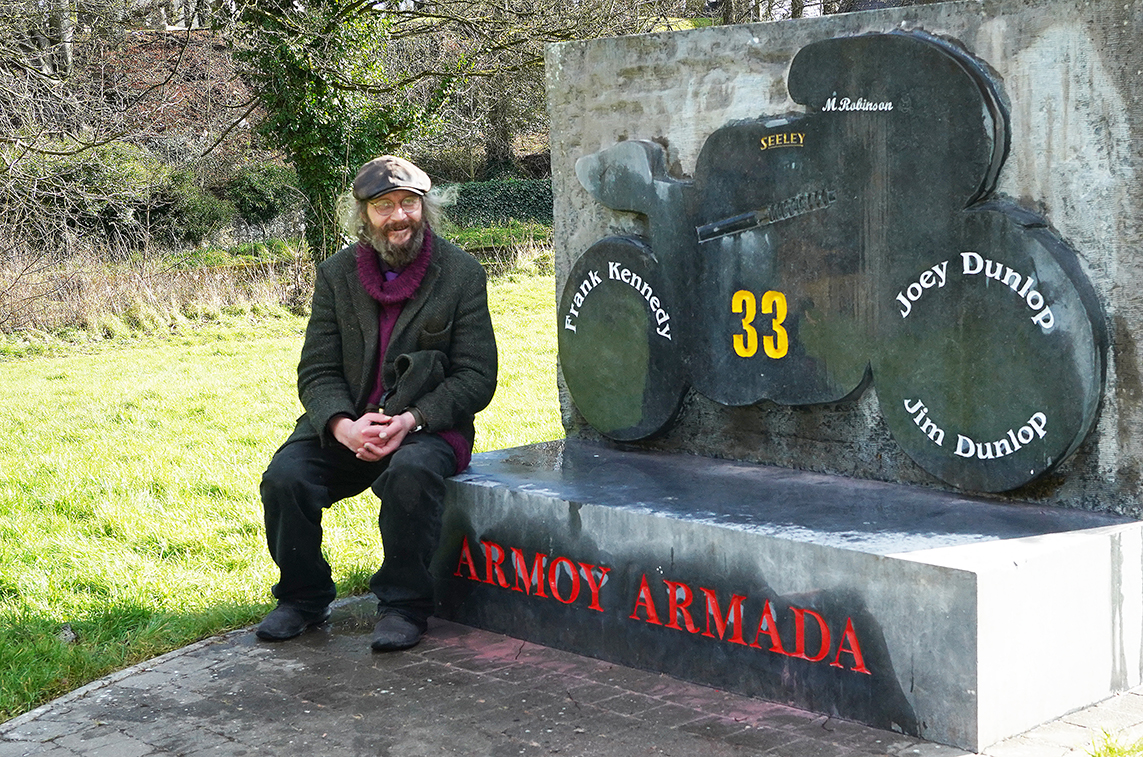Fourteen years after a memorial to the legendary Armoy Armada motorcycle team was unveiled in a park in Armoy, Northern Ireland, by the last surviving rider, Jim Dunlop, one of the men involved in making it has returned to finish it by painting his lettering.
He is architectural & monumental mason Mark Anthony Grimley (usually known simply as Mark Anthony), who worked on the Kilkenny limestone memorial with a fellow Belfast artist, Sean Doyle. He says he decided to paint the letters because "It was time".
The Armoy Armada was formed in 1977. It consisted of four riders – Mervyn Robinson, Joey Dunlop and his brother Jim, and Frank Kennedy.
They rode together as a team for just three seasons (although the Armoy road race lives on), but in that time earned the status of legends for their fearless riding, dedication to the sport of road racing, camaraderie and skill. The team came to an end when ‘Big Frank’ Kennedy was seriously injured in 1979 at the North West 200, another Northern Irish road race.
‘Robo’ Robinson’s career and life ended when he crashed at the 1980 North West 200. He lost control at the dreaded Mather’s Cross in the Portrush Road.
The best known of the Armoy Armada was Joey ‘The Girk’ Dunlop, who went on to a record-breaking 26 TT wins. He was made an MBE in 1986 for his services to motor racing and an OBE in 1995 for his charity work.
In 2000, at the age of 48, he died in a crash in Estonia, just weeks after winning the Formula One Isle of Man TT on a Honda VTR SP-1 and going on to complete a hat-trick with wins in the 250cc and 125cc classes.
There were 50,000 mourners at his funeral, which was attended by bike riders from across Ireland and the United Kingdom. A statue of him was erected in his home town of Ballymoney in Northern Ireland.
Mark Anthony’s life as an architectural & monumental stonemason has had its own interesting developments, which he is currently writing about as a biography. His achievements include 11 of his sculptures on permanent display in Belfast, the first from 1997. His work has also been included in exhibitions at Queens University in Belfast and Ulster Museum. His painting of the lettering on the Armoy Armada memorial brought out a local BBC reporter to feature him - not for the first time.
Mark Anthony trained in stonemasonry at Weymouth College in Dorset, cycling 20 miles to college each day from where he was staying in Salwayash, and then 20 miles back again each evening. While at Weymouth, he learnt lettercutting under the tutelage of Andrew Whittle, a celebrated lettercutter whose work includes inscriptions at Tate Britain and the Serpentine Gallery, the Animals in War monument in Park Lane, London, and at the Museum of Modern Art in Edinburgh.
Mark Anthony honed his conservation skills at Woodchester Mansion, the Victorian mansion left unfinished when the 19th century builders walked off site and never returned, unintentionally leaving behind an opportunity for training in traditional building skills in the 20th and 21st centuries.
His travels have taken him to Israel, where he worked on the conservation of stonework on the Damascus Gate, one of the main gates of the old city of Jerusalem. He worked in New Zealand, stopping off in Singapore on the way. He visited Borneo just because he wanted to see a proboscis monkey. He even lived in a cave for a while and was forced to stop working temporarily when he had both legs and his right arm broken in a collision with a car.
He married Amanda, who comes from Capetown in South Africa, after meeting her at the Natural Stone Show in London on his way back to Ireland from a trip to India.
“I’m at the age now where I’m slowing down a bit,” he says, and as well as carving public and private works and memorials, is enjoying helping others learn the benefits of working stone, as he has done with the Upper Springfield Development Trust and a project at a Poleglass estate that was opened by former Sinn Fein politician Gerry Adams.
In these projects he has worked with youth, women’s, disability, elderly and ex-prisoner groups, and school non-attenders. He likes creating art that involves the participation of others, both in its creation and its appreciation - like a public art sundial he made where the person viewing it acts as the gnomon that casts the shadow to read the time.
Mark poetically describes the quiet beat of carving and lettering stone as being like the rhythm of a beating heart, “the beat of life”, the connection between brain and hand therapeutically improving moods and easing pain, in the same way as auditory-tactile synesthesia, where an individual experiences tactile sensations in response to sound, or autonomous sensory meridian response (ASMR) that some experience.
“I love stone,” says Mark.
Anyone who would like to commission work from Mark or learn carving and lettering skills from him should email him on markbt15@live.co.uk or phone 02890 225458.
Below. A Janus Stone carved by Mark Anthony for art dealer Joe Brennan. It is in Joe's garden at his home in Greenisland in County Antrim.


Mark Anthony was filmed by the BBC as he worked.

